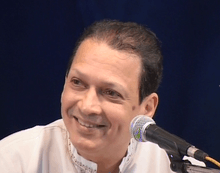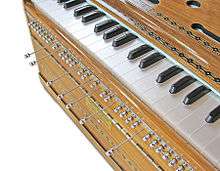Vidyadhar Oke
| Vidyadhar Oke | |
|---|---|
 | |
| Background information | |
| Birth name | Vidyadhar Gopal Oke |
| Born |
30 May 1952 Maharashtra, India |
| Genres | Hindustani classical music, Bhajan, Indian folk music |
| Occupation(s) | Harmonium Player, Doctor of Medicine, Music Researcher, Musical instrument inventor |
| Instruments | Harmonium |
| Website | www.22shruti.com |
| Notable instruments | |
| Harmonium | |
Vidyadhar Oke is a Doctor of Medicine and an Indian Harmonium player, who has done unique work [1] of 22 Shruti research and developed new musical instruments.
Early life
Oke is a Doctor of Medicine, M.B.B.S, M.D. (Pharmacology) from University of Mumbai, India. He later trained in Management at the London Business School[2] and Duke University, U.S.A; and in Clinical Research at Wellcome Trust, U.K. For years he gave services in the Pharmaceutical Industry but at 52 years, he gave away the post of President and dedicated himself to Music Research.[2][3]
Musical career
Oke, a renowned third generation harmonium artist [1][2][4] playing the instrument since the age of four,[5] later learned from the maestro late Pandit Govindrao Patwardhan [2][4] for 25 years [3] to become an ace Harmonium player.[6] His first public performance was a harmonium solo in 1972 on Mumbai Doordarshan.[4] He was a performing member at the National Centre for the Performing Arts (Mumbai) and played harmonium in music programmes at the centre, arranged by Purushottam Laxman Deshpande and Ashok Ranade. He taught Harmonium as Hon. Lecturer at the Department of Music, University of Mumbai. He accompanied on harmonium; singers including Asha Bhosale,[7] Vasantrao Deshpande, Sudhir Phadke, Kumar Gandharva, Manik Varma,[3][4][5] Malabika Kanan, Rashid Khan, C. R. Vyas, Jitendra Abhisheki, Vidyadhar Vyas, Suresh Wadkar, Jyotsna Bhole, Padma Talwalkar, Shruti Sadolikar, Satyasheel Deshpande, Asha Khadilkar, Upendra Bhat, Shubha Mudgal, Vijay Koparkar, Arati Ankalikar-Tikekar, Veena Sahasrabuddhe, Rahul Deshpande; and played with Solo Tabla by Alla Rakha, with Vocal and Mridangam by T. V. Gopalakrishnan.
He performed in India [8][9] presenting new experiments on Harmonium. He also performed in United States and Europe,[4] including a concert in Maharashtra Mandal of London, to support the fund for the victims of 1993 Latur earthquake; and in the convention of Brihan Maharashtra Mandal of North America at Houston, USA. He archived 400 songs from 14 Marathi Dramas played by his Guru, Govindrao Patwardhan. He won the 5-year competition for the Best Amateur Music Director held by Chaturang and adjudged by Shrinivas Khale, Datta Davjekar, and Meena Khadikar. He composed Music for Marathi Musical theatre, for Dramas including Sanyastha Jwalamukhi based on the life of Swami Vivekananda, and Dnyanoba Maza based on the life of Saint Dnyaneshwar.
22 Shruti Research
Indian classical music recognises 22 shrutis (the basic musical notes[4] or microtones[5]) which create ragas. Although the world started measuring musical notes in terms of Hertz as early as in 1930, Indian classical music is still not taught scientifically but only through tradition. Through his insightful and revolutionary research, Oke accurately pinpointed the positions and corresponding frequencies of 22 shrutis, which are completely Indian,[1] and thus showing their difference from the notes of the equal temperament scale.[3][10] He demonstrated that the sequential progression of 22 shrutis can be plotted mathematically, enabling a player to easily play a note on a string precisely every time.[3] He also clarified the essential difference between nāda and shruti, along with the naturally defined regions of 12 universal notes on any string instrument,[11][12] and how an alankara or gamaka (ornament) is created by their combination,[13] together with the precise positions of 22 shrutis.[14]
Invention of Musical Instruments


The discovery has led Dr. Oke to create new instruments such as the 22 Shruti Harmonium, 22 Shruti Veena, 22 Shruti Metallophone, and 22 Shruti Tanpura.[3][12] A typical Harmonium has 12 shrutis or basic musical notes [2][4] and was considered an instrument with limitations in Indian Classical Music, as it could not render all the nuances of Indian Ragas.[5] Classical Singers used to performing with Tanpura were not comfortable with harmonium [2] tuned to the 12-Tone European Equi-tempered scale, which therefore is completely unsuitable to the Indian Classical Music, giving all the notes in wrong positions.[15] To gel with Tanpura, an ideal instrument should have 22 shrutis.[2] Oke discovered the mathematical method used by ancestors for the division of shrutis,[4] developed an improved harmonium capable of playing 22 shrutis – fractional notes or microtones , and patented his design for the first time in India,[5] a maiden recognition of the otherwise humble instrument.[1] Oke who has an eye for detail,[1] made structural changes providing a knob each under 12 keys, positioned for upper and lower shrutis. In this way, the 22 shruti harmonium can be tuned for any particular raga by simply pulling out knobs wherever a higher shruti is required [16][17][18] as demonstrated on 22-Shruti-Harmonium for Ragas e.g., Todi vs Multani,[19] Pooriya vs Marwa,[20] and Bhoop vs Deshakar.[21] In this way, it is more useful to render most nuances of Indian ragas.[1]
Musically creative people can go to any length to add an extra bit to their designs as is evident in his creation, the 22-Shruti-Harmonium, which can also double up as an Accordion,[1] by adjusting the knobs under every key.[22]
Oke presented his 22-Shruti-Harmonium in the session on 'Some New Scientific Approaches to Music' in the Seminar of Indian Musicological Society, held on 15 January 2010 at the National Centre for the Performing Arts (India), Mumbai; referring to different interpretations and giving a detailed explanation of the frequencies of different shrutis and their inter-relationships together with the nature’s frequency ratios.[23] Oke’s 22-Shruti-Harmonium is a fresh refinement in the instrument providing intermittent shruti notes, as traced in Partho Sengupta’s film on ‘Harmonium’ screened at the Bangla Academy in Calcutta Film Festival.[24] Vocalists now should insist on having this 22-shruti harmonium.[5]
Appreciation of Research by Stalwarts
Oke’s 22-Shruti research is seen closely in person and applauded by top Indian Classical Musicians as follows.[11][12]
This extraordinary work should be given and awarded due and deserving recognition. It gave me an experience of Swarabrahma.
Oke’s research deserves a Nobel prize. His harmonium should be made mandatory to all Indian Classical Music vocalists all over the world.
No one has done such accurate work before.
This work is very useful. You should take your harmonium to Vocalists.
His work should undoubtedly be useful to both music students and practitioners.
Oke’s research work is a toneful addition to Indian Classical Music.
This research is the absolute truth whether people accept this or not.
I wonder how are you sitting in anonymity in spite of doing such a big accomplishment.
The evolution of this formula has set at rest all the past discussions and disputes over the positions of shrutis – an achievement that will be written in golden letters in the history of music.
Orator
Oke gave Lectures and Scientific demonstrations on his research on 22 Shrutis at the ITC Sangeet Research Academy (Kolkata), Dr. Prabha Atre Gurukul (Pune), Gandharva Mahavidyalaya (Mumbai), University of Rajasthan (Jaipur), Whistling Woods International Institute (Mumbai), Shrutinandan : Music Institution of Pt. Ajoy Chakrabarty (Kolkata), National Centre for the Performing Arts (Mumbai), Gaanavardhan (Pune), Banasthali Vidyapith (Rajasthan), Gandharva Mahavidyalaya (Pune), Kala Academy (Goa), Sarvajanik College of Performing Arts – SCOPA (Surat, Gujarat), Gosavi Sangeet Gurukul (Nashik), Audio Engineering Society (Mumbai), Marathi Vidnyan Parishad (Boisar), Sangeet Kala Academy of Brihanmumbai Municipal Corporation (Mumbai), Khalvayan (Ratnagiri), Deenanath Mangeshkar Hospital, Bhabha Atomic Research Centre (Mumbai). He gave interviews on Zee TV, Akashvani, ABP Majha TV, Mumbai Dooradarshan, and World Space Radio. He also delivered a TED-X talk on his 22 Shruti research at IIT Gandhinagar [25]
Oke created and implemented the world’s first educational course on 22 Shrutis entitled ‘SHRUTI-NIPUN’[12]
Author
- 22 Shrutis (English - 2007, Marathi - 2010, Hindi - 2015), Sanskar Prakashan, Mumbai.
- Shrutigeeta, Madhav Rafter Publications - 2011 [11]
- Shrutividnyan Va Ragasoundarya, Rajhansa Prakashan - 2015 [12]
Astrologer
A student of Late Pandita Leelatai Paranjpe, Oke has studied Hindu astrology, Chinese astrology, Western astrology, written newspaper articles, authored books,[26] [27] given invited lectures,[28] besides presenting a daily Astrology programme on ETV Network, Mumbai.
Awards
- P.L.Deshpande Award (Uttung Sanskrutik Pariwar, Mumbai)
- Bandubhaiyya Chougule Puraskar (Indore)
- Appasaheb Jalgaokar Puraskar (Ganavardhan, Pune)
- Keshavrao Bhosale Award by Govt. of Maharashtra
- Thane Bhushan Award (Thane Municipal Corporation)
- Thane Nagar Ratna Award (Nagar Vikas Manch)
- Thane Manabindu Award (Maharashtra Times-Indradhanu)
- Anil Mohile Award (Siddhakala Academy)
- Vinayak Damodar Savarkar Award (Savarkar Nyasa)
- Dr. Sharadini Dahanukar Hirvai Sanman (King Edward Memorial Hospital)
- Swara-Kranti Award (Nadabrahma)
- Sahavadak Puraskar (Swarabandh, Mumbai)
- Surmani (Sur Singar Samsad)
- Leadership through Innovation Award (Wockhardt)
Personal life
Vidyadhar Oke is married to Bhagyashree Oke. She is a Kathak Dancer. They have three sons, Anand, Amod and Aditya Oke. Aditya is also a harmonium player.[4] His daughter-in-law Vedashree Oke is a stage actress and a singer.
References
- 1 2 3 4 5 6 7 Anandi Mishra. "Young musicians fuse tradition with technology". Times of India. Archived from the original on 12 June 2016.
- 1 2 3 4 5 6 7 Asheesh Kumar Shukla. "In Perfect Harmony". DNA SYNDICATION. Archived from the original on 28 November 2011.
- 1 2 3 4 5 6 DNA webdesk. "#LifeIsMusic: Dr Vidayadhar Oke on the 22 Shrutis in Indian Classical Music". DNA India. Archived from the original on 14 July 2015.
- 1 2 3 4 5 6 7 8 9 Sana Yaseen. "Creating some great harmony". DNA SYNDICATION. Archived from the original on 19 February 2010.
- 1 2 3 4 5 6 Prachi Pinglay. "Man gets patent for 22-note harmonium". Hindustan Times. Archived from the original on 17 January 2012.
- ↑ Dr. Asha Mandpe. "An artistic veneration for the gurus - The Times of India". The Times of India. Archived from the original on 18 July 2009.
- ↑ https://www.youtube.com/watch?v=zXlcxaeXFY0
- ↑ https://www.youtube.com/watch?v=Q2R26K0IhtU
- ↑ https://www.youtube.com/watch?v=ujjqhaj5cQE
- ↑ Yogesh P. Pingle. "Predicting Shrutis in Harmonium using Temporal Mining" (pdf). International Journal of Engineering Research and Applications. Retrieved 30 March 2012.
- 1 2 3 Oke, Vidyadhar (2011), Shrutigeeta, Madhav Rafter Publications, pp. 244–270, ISBN 978-81-922379-2-3
- 1 2 3 4 5 Bakre Sadashiv, Oke Vidyadhar (2015), Shrutividnyan Va Ragasoundarya, Rajhansa Prakashan, pp. 5, 86, 88–104, ISBN 978-81-7434-853-1
- ↑ https://www.youtube.com/watch?v=qPpNQ0uDqgA
- ↑ https://www.youtube.com/watch?v=PQjWyBvLfqM
- ↑ Kaur, Dr. Narendra (July 2014), History and Development of Harmonium in India and its Place in Gurbani Kirtan, Vol. 3, No. 2, pp. 15–20, ISSN 2319-9695
- ↑ Reed Organs in England
- ↑ Pump organ - On the Indian subcontinent
- ↑ https://www.youtube.com/watch?v=2QuK6cJon8w
- ↑ https://www.youtube.com/watch?v=Z8BpNYND548
- ↑ https://www.youtube.com/watch?v=JdmSKmG6A2A
- ↑ https://www.youtube.com/watch?v=XLXQJ-mXbF8
- ↑ https://www.youtube.com/watch?v=7BePHjWIFgw
- ↑ A. Seshan. "Some New Scientific Approaches to Music" (pdf). Music Research Library. Retrieved 15 January 2010.
- ↑ "Harmonium history". The Telegraph. Archived from the original on 27 November 2011.
- ↑ TEDx IIT Gandhinagar. "The science of music". TEDx. Archived from the original on 13 October 2014.
- ↑ Oke, Vidyadhar (2002). 'Manoranjak Swabhavashastra', An Astrological treatise on the Chinese Astrology. Udveli Books.
- ↑ Oke, Vidyadhar (1996). 'Mitra Jivacha', An astrological treatise on the Chinese system of I Ching. Kasturika Communications.
- ↑ http://rotaryqueensnecklace.org/pdf/glitters02-0809.pdf